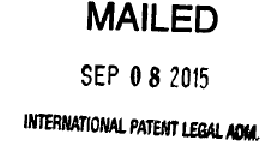 Despite having been told many times to take corrective measures, USPTO has even now not moved its backup e-filing server to a redundant location. This causes great harm to customers of the USPTO. See, quoted above, the notice appearing today on USPTO’s web site. Continue reading “All USPTO patent e-filing systems are broken”
Despite having been told many times to take corrective measures, USPTO has even now not moved its backup e-filing server to a redundant location. This causes great harm to customers of the USPTO. See, quoted above, the notice appearing today on USPTO’s web site. Continue reading “All USPTO patent e-filing systems are broken”
USPTO now provides PDF patents
In our patent firm, every day somebody needs to obtain a US patent or published US patent application as a PDF. We send the PDFs to clients and foreign agents and we save them to our own file servers for internal use.
US patent or published US patent application as a PDF. We send the PDFs to clients and foreign agents and we save them to our own file servers for internal use.
For many years USPTO went out of its way to make it very difficult for a user to obtain a copy of a US patent or published application, providing only TIF images (not PDFs) and those only one page at a time. Users wanting a PDF had to use software such as GetIPDL which would download the TIF images one by one and stitch them together into a PDF. Another approach for a user was to draw upon any of a number of private web sites for a multipage PDF of a patent. Some of these private web sites charged money for the PDFs, and one of them tacked an advertising message across the bottom of the first page of the PDF.
Now the USPTO has quietly changed its PatFT (patents full text) and AppFT (patent application full text) databases so that with the click of a mouse, the user can view a multipage PDF containing all pages of a patent or published application. With another click of the mouse (see the “full pages” button above), the user can download the PDF and make normal use of it.
Refreshingly, USPTO has done this in a way that tacks the Certificate of Correction (if any) onto the back of the PDF.
What one wishes, of course, is that USPTO would provide a “constructable” link which would directly yield the PDF file. The wish is that a link along the lines of https://www.uspto.gov/patents/7123456.pdf would retrieve a PDF of US patent number 7123456 and something similar for published US patent applications. As far as I can see the new USPTO system does not provide such a constructable link. Instead USPTO seems to have designed this new “full pages” link in a way that requires a human being to do the mouse clicks to obtain the PDF file.
Setting aside my disappointment about the lack of constructable links for the PDF files, the fact is that USPTO has moved closer toward actual user-friendliness in this area. Kudos to the USPTO!
Fast appeals for Small Entities
Readers will recall that in June 2015, the Patent Trial and Appeal Board announced its two-for-one sale. Any filer that had two ex parte appeals pending as of June 19, 2015 could get one of the appeals decided right away by dropping the other appeal. When the PTAB announced this program, I blogged about it. I noted that this program was likely to be of interest only to sophisticated, high-volume corporate filers, since only such filers would (a) have two appeals pending and (b) be in a position to make a decision to drop an appeal in a case that previously seemed important enough to appeal. I noted that few if any small or micro entities would be able to use this program because they would not have two appeals pending (one of which would have to be dropped to qualify for the two-for-one program). I predicted that very few filers (large or small) would actually choose to use this two-for-one program, and my prediction turned out to be correct.
Now the PTAB has announced a second program for getting ex parte appeals decided fast. This second program, fetchingly named S-EPAP for Small Entities, is described in a Federal Register notice dated September 15, 2015 and on an FAQ page. This program permits a small entity or micro entity to get an ex parte appeal decided fast under certain conditions.
It is interesting to note USPTO’s explanation for setting up this second fast-appeals program:
Members of the public noted that small entities having only one appeal pending before the PTAB would not be able to take advantage of the EPAP program to secure expedited review of an ex parte appeal.
It seems I was one of those “members of the public”.
So how does this second, new fast-appeals program work? Continue reading “Fast appeals for Small Entities”
PTAB’s two-for-one sale — three months on
Readers will recall that in June 2015 the Patent Trial and Appeal Board announced its Expedited Patent Appeal Pilot. This is the program in which, if you have two ex parte appeals pending, you could abandon one of them and the PTAB would decide the other one faster. I blogged about this program and I predicted that very few applicants would choose to use this program. How did my prediction turn out? Continue reading “PTAB’s two-for-one sale — three months on”
Supreme Court says patent applications are difficult to draft
I am indebted to Louis Ventre, Jr. for pointing out this delightful quotation from the US Supreme Court in 1892:
The specification and claims of a patent, particularly if the invention be at all complicated, constitute one of the most difficult legal instruments to draw with accuracy; and, in view of the fact that valuable inventions are often placed in the hands of inexperienced persons to prepare such specifications and claims, it is no matter of surprise that the latter frequently fail to describe with requisite certainty the exact invention of the patentee, and err either in claiming that which the patentee had not in fact invented, or in omitting some element which was a valuable or essential part of his actual invention.
Topliff v. Topliff, 145 U.S. 156, 12 S.Ct. 825, 36 L.Ed. 658.
Maybe it should be standard procedure to send a copy of this quotation to each client when they complain about the cost to get a patent application drafted.
fuliginous
Wow. If you want to learn a new word now and again, hang out with the folks in the PCT Listserv. Here’s a PCT Listserv posting of earlier today by list member Jim Boff:
I think you have said it all.
- The requirements of the US are seen by the rest of the world as replete in fuliginous obscurity.
- The requirements of the rest of the world are seen in like respect by the US.
- The rest of the world is not in total harmony and look upon each other in suspicion.
- Patents are property and people get difficult about property.
- If there was such a thing as a form of patent assignment that was agreed valid in all jurisdictions and that required minimal formalities to be valid everywhere that would be a wonderful thing and devoutly to be wished for.
But you mention notarisation?
If you want it simple there has to be compromise everywhere on formalities, in the US as well as outside the US.
Jim Boff
Unexpectedly fast PCT-PPH decisions at USPTO
Note: what seemed like an improvement at the USPTO regarding PPH petitions turned out to be illusory. Please see a followup article about this.
There are two ways to pursue US patent protection from a PCT patent ap plication:
plication:
- entry into the US national phase, and
- filing of a bypass continuation application,
and there are many factors which might influence a particular filer’s choice of one approach or the other. Now there is yet another factor, namely the speed with which a PPH petition might get granted. If you pick “US national phase”, your PPH petition will nowadays likely get decided in a few days rather than a few months. As I will describe below, a couple of weeks ago we filed about fifty PCT-PPH petitions, and we figured we would have to wait the usual four to seven months for USPTO to decide them. We were astonished when seven of these fifty PCT-PPH petitions got decided in less than three weeks. It turns out there is an easy explanation for this happy result. Continue reading “Unexpectedly fast PCT-PPH decisions at USPTO”
Dealing with the ways that USPTO mangles images
When you e-file an image in a USPTO e-filing system, what often happens is that the USPTO mangles the image. I will describe some of the thi ngs that can go wrong and will give a few tips on minimizing the extent of the mangling. Continue reading “Dealing with the ways that USPTO mangles images”
ngs that can go wrong and will give a few tips on minimizing the extent of the mangling. Continue reading “Dealing with the ways that USPTO mangles images”
Looking back over twenty years of service
Oppedahl Patent Law Firm LLC, and its predecessor firms, has been serving clients now for over twenty-two years. This got me thinking of some of the firm’s milestones over the years. Here are some of the high points:
Continue reading “Looking back over twenty years of service”
Avoiding having to translate two documents into English
A question came in from a good friend:
A client from a non-US country wants to enter the United States at the end of the PCT which was filed in a non-English language. He is working on a CIP but won’t have it ready until another few months. He would like to try and avoid the cost of a double translation. Can you think of a way for him to enter into the US at the end of the 30 months with the non-English language version, and somehow avoid having to translate that application, and then in a few months when he has the CIP ready here he will file that in the US and translate that one into English. My concern is that without filing an English translation of the first application, is he able to get somehow a valid US filing date?
Here’s what I think the answer is. Continue reading “Avoiding having to translate two documents into English”
